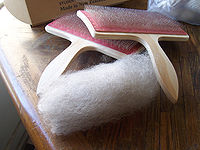
Long draw (spinning)
Encyclopedia

Spinning (textiles)
Spinning is a major industry. It is part of the textile manufacturing process where three types of fibre are converted into yarn, then fabric, then textiles. The textiles are then fabricated into clothes or other artifacts. There are three industrial processes available to spin yarn, and a...
technique used to create woolen
Woolen
Woolen or woollen is a type of yarn made from carded wool. Woolen yarn is soft, light, stretchy, and full of air. It is thus a good insulator, and makes a good knitting yarn...
yarn
Yarn
Yarn is a long continuous length of interlocked fibres, suitable for use in the production of textiles, sewing, crocheting, knitting, weaving, embroidery and ropemaking. Thread is a type of yarn intended for sewing by hand or machine. Modern manufactured sewing threads may be finished with wax or...
s. It is spun from carded
Carding
Carding is a mechanical process that breaks up locks and unorganised clumps of fibre and then aligns the individual fibres so that they are more or less parallel with each other. The word is derived from the Latin carduus meaning teasel, as dried vegetable teasels were first used to comb the raw wool...
rolag
Rolag
A rolag is a roll of fibre generally used to spin woollen yarn. A rolag is created by first carding the fibre, using handcards, and then by gently rolling the fibre off the cards...
s. It is generally spun from shorter stapled fibers. Long draw spun yarns are light, lofty, stretchy, soft, and full of air, thus they are good insulators, and make good knitting
Knitting
Knitting is a method by which thread or yarn may be turned into cloth or other fine crafts. Knitted fabric consists of consecutive rows of loops, called stitches. As each row progresses, a new loop is pulled through an existing loop. The active stitches are held on a needle until another loop can...
yarns.
Long draw spinning is most often contrasted to the short draw
Short draw (spinning)
Short draw is the spinning technique used to create worsted yarns. It is spun from combed roving, sliver or wool top- anything with the fibers all lined up parallel to the yarn. It is generally spun from long stapled fibers. Short draw spun yarns are smooth, strong, sturdy yarns, and dense. Short...
technique used to spin worsted
Worsted
Worsted , is the name of a yarn, the cloth made from this yarn, and a yarn weight category. The name derives from the village of Worstead in the English county of Norfolk...
yarns.
Technique
The first step to spin a true woolen yarn is to card the fiber into a rolagRolag
A rolag is a roll of fibre generally used to spin woollen yarn. A rolag is created by first carding the fibre, using handcards, and then by gently rolling the fibre off the cards...
using handcarders.
The rolag is spun without much stretching of the fibers from the cylindrical configuration. The hand holding the fiber is the active hand, and the one closer to the wheel is passive. The passive hand smooths yarn, picks out vegetable matter, and pulls out extra bits of fluff, but that is all. The work of drafting is done by the active hand, and most of the regulation and smoothing of yarn is done by twist and tension.
Drafting is done by pinching off a short section of the rolag, and then pulling back while twist is added to it. The active hand pulls back until the yarn is the desired thickness. The passive hand controls how much twist is allowed in the drafting yarn: too much twist and the yarn won't draft; too little and the yarn will break. Twist concentrates in the thin areas of the yarn, solidifying these. Thus the tension doesn't stretch these parts thinner, but instead drafts the thicker parts until all the yarn is approximately the same thickness. This has the effect of automatically thinning out the thicker parts, which is what allows this technique to work.
Once the yarn is the desired thickness, enough twist is added to make the yarn strong. In effect, this is done by releasing the passive hand. Next the yarn is wound onto the bobbin, and the process starts again.
In use
Most handspinners make a blend of a woolen and worsted yarn, using techniques from both categories, and thus ending up with a mix, named a semi-worsted yarn.External links
- PDF version of relevant SpinOff article - Provides step by step instructions with pictures

